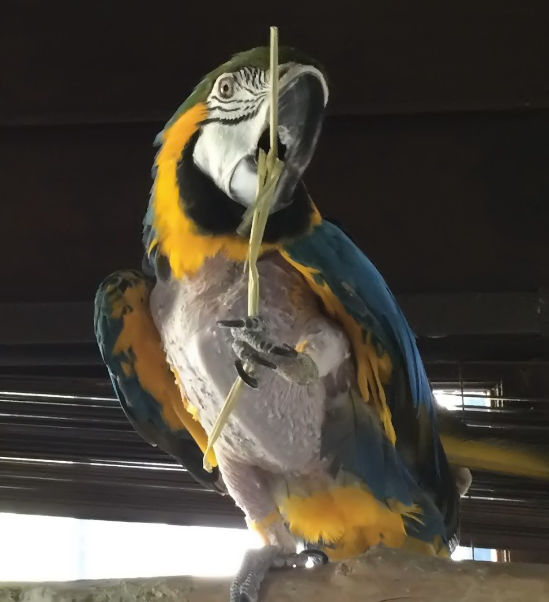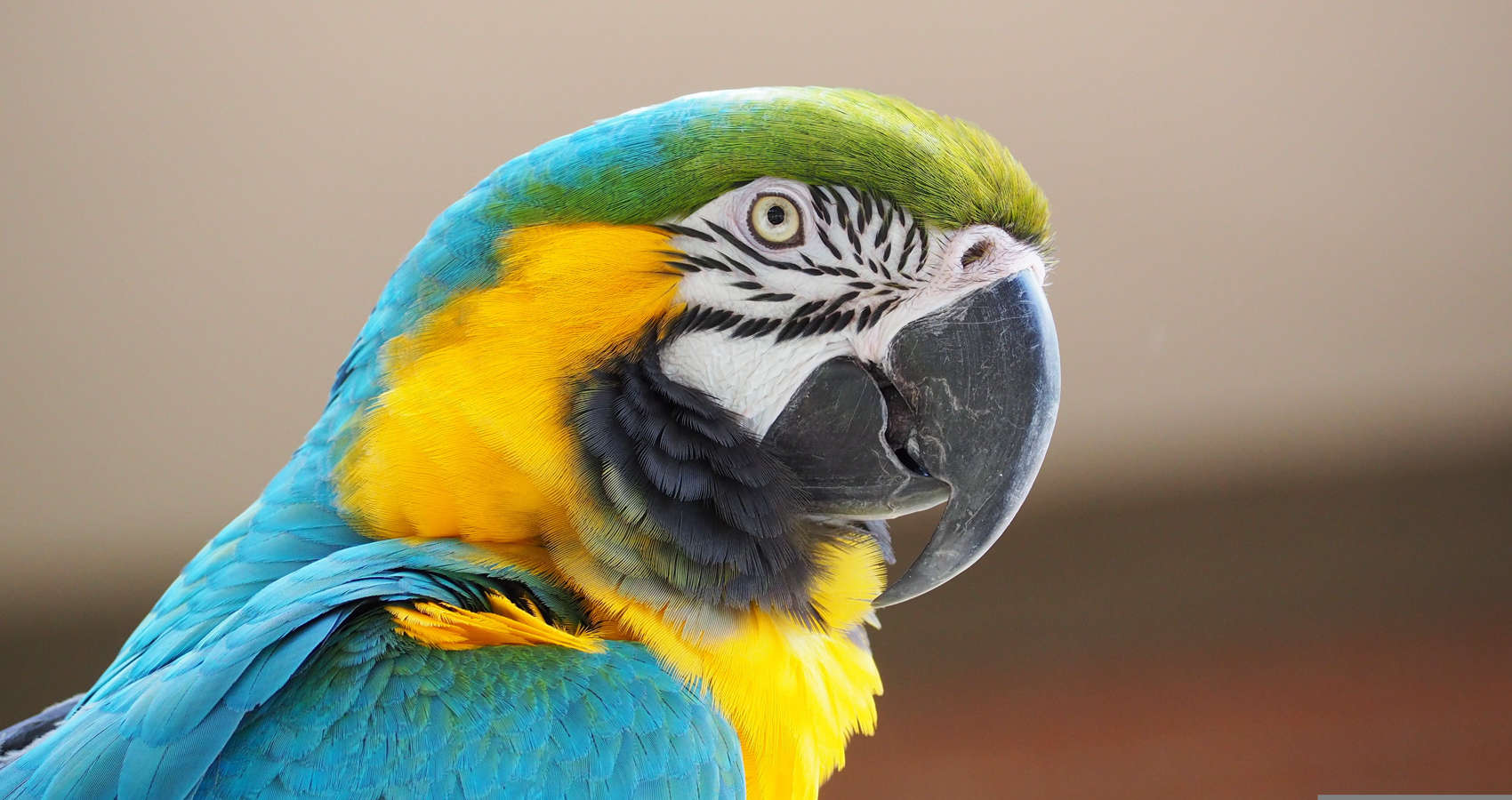Mary McGregor’s Talking Macaw
written by: Craig E Harms
 “She was not quite what you would call refined. She was not quite what you would call unrefined. She was the kind of person that keeps a parrot.”
“She was not quite what you would call refined. She was not quite what you would call unrefined. She was the kind of person that keeps a parrot.”
– Mark Twain, Crossing the Equator
Yellow Medicine County assessor Mary McGregor had a short commute to the courthouse–three blocks residential; two, downtown (which was the entire length of the Granite Falls business district). She mostly walked to work, firing up the Ford only in winter (which in these parts could run October through May). With a census population of only 9,528 citizens, her job taxing wasn’t as taxing on her as it was on Yellow Medicine County property owners.
The county was established by the Minnesota legislature on March 6, 1871 after the Dakota Sioux who lived there were pressured into ceding land to the United States in a series of treaties signed in 1837, 1851, and 1858. Four bands of the tribe, particularly the Mdewakanton, were displaced and reluctantly removed and confined to the nearby Upper Sioux Indian Reservation a mere twenty miles wide, ten on both sides of the Minnesota River. The human corral was established under the Treaty of Traverse des Sioux in 1851.
Mary led a content life with her husband she married right out of Granite City High School until he broke his neck after getting blown off the roof while shingling. The silent house (assessed at $65,335.25), devoid of his baritone voice, and now, those of any possible offspring, became unbearable to the widow. She poured over numbers all day hearing pins drop–she didn’t need more quiet when she got home.
Maybe a pet, she thought one May morning, walking to work, stopping at Carl’s Critters, an animal-shelter-for-profit in a building that formerly housed the town’s last grocery store. A cat? Nah, will shred the furniture like cabbage. A dog? Alone in the house for eight and a half hours a day? Ain’t gonna happen. Fish? No, because their environment is just as mute as mine!
She thought no more about it until a month later, when, on her way home dreading another date night with HBO and ice cream, she noticed a parrot in Carl’s Critters pet shop window looking as forlorn and lonely as she was. Stuffed into a too-small cage, self-mutilated because of boredom, abuse, and neglect, the poor blue-and-gold macaw (or what was left of the blue and gold) looked like it sorely needed a companion as much as she did. Carl told her the bird he called Buddy was left on his front step the night before, and he would sell it cheap–and toss in the too-small-of-a-cage for free. Buddy found a home.
It took many patient months for the bird to trust his new human roommate–four just to perch on her finger; another six, her shoulder–but slowly, but surely, he began to relax in his new environment–and even began to talk.
Mary was in the kitchen, sleep-cooking through another dinner-for-one, when she heard Buddy speak his first word. (Parrots have a tendency to “practice talking” when “their person” isn’t present. Avian behaviorists have yet to figure out why).
“Sue!” he said clearly, after months of mumbling gibberish.
“What’s that?” Mary squawked back, so surprised that she almost cut her finger chopping up an onion that was on its way to another week’s worth of goulash.
“Sue!”
“Name’s Mary!”
“Sue!”
“Mary!”
“Sue! Sue! Sue!”
“Mary! Mary! Mary!”
She and her husband had had a few dust-ups in their short marriage and she was generally as calm as her job required, but she never thought she would see the day when she would be arguing with a parrot!
This banter, almost on loop, carried on for several more weeks until Buddy came up with a new one. Now entrusted enough to spend more time outside the cage than in it, he was perching proudly on his tree stand one evening, stretching his wings like they were meant to be stretched, and announced, “Big Eagle!” Mary gasped in surprise that he had learned two new words, then chuckled in joy at his raptor imitation and accompanying verbal description.
In time, he merged the two, repeating an incessant, “Sue! Big Eagle!”
One evening, one late September, Mary ate her last leftovers, washed and dried her plate, drinking glass, fork, butter knife, and the casserole dish that was empty at last, and sat on the couch, remote in hand, excited to watch the new fall lineup on the tube. Buddy, perching next to her on his manzanita branch (a macaw can bite a broomstick in half, so hardwoods are necesito), didn’t seem as interested.
“Sue! Big Eagle!”
“Not now, Buddy! I’m trying to watch TV.” (FIDs, an acronym for “feathered kids” always seem to act up whenever you don’t want them to, much like their sapien counterparts.)
“Sue! Big Eagle! Sue! Big Eagle!”
“Come on, Buddy. My show’s just coming on.”
“Sue! Big Eagle! Sue! Big Eagle! Sue! Big Eagle! Sue! Big Eagle! Sue! Big Eagle! Sue! Big Eagle! Sue! Big Eagle!”
“SHUT THE FUCK UP, BUDDY!”
It was the first (and last) time Mary McGregor ever got mad at her feather-plucked friend; alas, the long, slow fuse of a meticulous numbers-cruncher burns fast when the resolution to last season’s cliffhanger is about to come on.
“No—YOU shut the fuck up, Mary!” the bird shot back, enunciating as distinctly as the voice on the commercial she suddenly stopped watching. “You don’t seem to understand. When I parrot, ‘Sue!’, I mean, Sioux. S-I-O-U-X. A member of the people who lived here before you stole our land.”
Mary’s cliffhanger was suddenly not so all-consuming.
“And when I parrot the words ‘Big Eagle,’ that was my Sioux name until my spirit was shapeshifted into this reality. This shadow world. I was born in 1827, as you mark time, and was the chief of a band of Mdewakanton Dakota in this very part of Minnesota. I died in 1906.”
“Okay, Buddy, this is nuts!“ Now Mary began to feel as if she, herself, was a player on a plywood set somewhere out in LaLaLand. She fumbled for the off pad and turned fully gobsmacked towards her suddenly eloquent pet bird.
“Our people believe in totems – a connection with an animal that will accompany us in the next world. My spirit came back as this macaw, symbolic of my former life: a once proud, beautiful creature reduced to living in cramped, squalid conditions, abused, neglected, forgotten. It is my punishment from the Great Spirit for losing our homeland. It is what your religion calls hell.”
“ ”—Mary was too shocked to squeeze out a reply. Now Buddy’s rote vocalization of a few measly syllables seemed nothing much to gush about.
“Our lives were as they were meant to be, until the encroachment began. The wave of the white settler population in Minnesota Territory had grown from 6,077 in 1850 to 172,072 in 1860, after it had become a state. The dam had burst.”
Mary grew as stiff and cold as the ubiquitous icicles that hang around these parts for months on end.
Buddy, on a vocal narrative roll, continued: “The whites were always trying to make the Indians give up their life and live like white men–go to farming, work hard as they did–and the Indians did not know how to do that, and did not want to anyway. It seemed too sudden to make such a change. If the Indians had tried to make the whites live like them, the whites would have resisted, and it was the same way with many Indians. The Indians wanted to live as they did before the Treaty of Traverse des Sioux–go where they pleased and when they pleased, hunt game wherever they could find it, sell their furs to the traders, and live as they could.”
“As you may or may not know, Mary, we lost the Dakota War of 1862 that took place right here in what would become Yellow Medicine County. Soon after the final skirmish at Wood Lake, I, with many others who had taken part in the war, surrendered to Colonel Henry Hastings Sibley. Our deaths were plentiful, although not without purpose: By the end of the war, we had killed 358 settlers, in addition to 77 soldiers and 29 volunteer militia.”
Mary wasn’t quite sure now that this wasn’t the shadow world.
“Afterwards I was tried, and I served three years in the prison at Davenport, Iowa, and the penitentiary at Rock Island, Illinois, for taking part in the war. On my trial, a great number of the white prisoners, women and others, were called up, but not one of them could testify that I had murdered anyone or had done anything to deserve death, or else I would have been hanged, as your Great Father in Washington, President Lincoln, pardoned me. Yet, he approved the death sentences for 39 out of the 303 of us. On December 26, 1862, 38 of our people were hanged. This was the largest one-day mass execution in American history. Had we known the outcome, we surely never would have surrendered. My brief prison time was mere preparation for this longer penitent life behind bars.”
Mary was as wide-mouthed as one of the canning jars she used when she and hubby grew a garden.
“I must atone for my sin so that I can return to our land before it was sliced, diced, plotted, and sold. So that we, the band of Mdewakanton Dakota, can rise again!”
Now Mary noticed Buddy’s body language, lessons learned the hard way–eyes pinned in a lizard-like squint; beak scraping the perch back and forth, as if sharpening it on a razor strop; nape feather fluffed up; the agitated back-and-forth side-step on the manzanita perch. Recognizing this look–a cue that she learned quickly to back away from the bird–saved her a lot of money on Band-aids.
“I inherited this form on January 5, 1906, the time of my physical leave, and have been caged since. From behind these second sets of bars, I have witnessed the degradation of our land. The divisions. Subdivisions. The pollution and the poisons. And then you came along, Mary . . . thinking you could place a monetary value on a square of soil–then tax it! For your all-consuming greed. HA!”
Now she grew fearful–the bird was worked up in a great state of discomposure, as agitated as a turkey who knew full well the next day was Thanksgiving.
“I must absolve my sin. Return to my reality. Thank you for setting me free.”
When Mary McGregor missed two straight days of work without calling in, her co-taxers-of-land became worried and asked the sheriff’s department to do a house check on her. Her body was found lying on and around the living room carpet, once beige, now soiled in splatters and tatters of blood and skin, looking like it was attacked by a thousand can-openers.
(Co-workers at the courthouse said later that while they enjoyed Mary’s bird stories and photos, the assessor seemed to become more and more obsessed with it, talking in terms as if the bird was almost human—a common phenomenon among parrot-people that parrotless-people, refined or unrefined, will never understand!—and that she always felt completely safe around it.)
The cops found Buddy calmly perched on his manzanita branch, pulling flesh apart from a dislocated cheekbone. A sheriff’s deputy said later, and off the record, that the bird gave out an ear-piercing “SUE! BIG EAGLE!” before it was removed to old Doc Miller’s place out in the country and euthanized.
Set free.
Folks in rural Yellow Medicine County, Minnesota, claim they can hear the drifting chants and bells of an Indian powwow sometimes rustling through the cornfields when the wind blows just right. Perhaps Coronel Sibley didn’t win the Dakota War of 1862 after all.
- Kneadin’ Lois Krogmieir - December 15, 2025
- AAEVEYN ULLOVTO’s Scrabbled Psyche - November 29, 2025
- Enter Life - June 7, 2025



